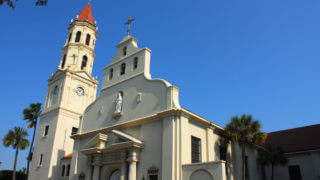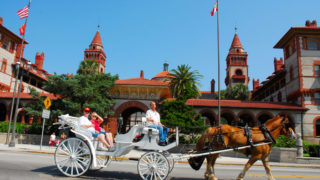Spanish Military Hospital Museum
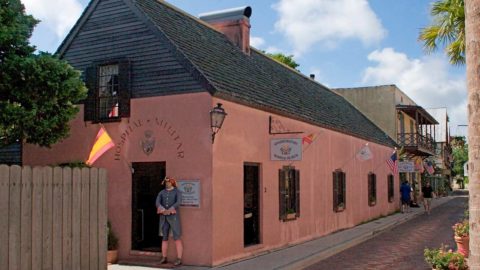
Spanish Military Hospital Museum
The Spanish Military Hospital Museum offers visitors a look into how healthcare operated during the Spanish Colonial Period. The building that the museum is housed in is a reconstruction of a Military Hospital that was on the same site in the late 1700s. As you tour the museum, you’ll be given an inside look into how patients were treated here. From the ward beds to the surgeon’s tools and even the mourning room where patient’s last rites were given by Priests, the museum is an interesting and unique spot to see.
 The hospital is located on Aviles Street, which was originally known as Hospital Street because the medical facility was situated along the roadway. The medical clinic treated military personnel during St. Augustine’s Spanish and British Colonial periods. The original hospital complex consisted of three main structures and several outbuildings. The West Wing, built during the First Spanish Period, burned down in 1818. The British constructed the East Wing and Apothecary. The hospital was closed two years after the United States assumed control over Florida.
The hospital is located on Aviles Street, which was originally known as Hospital Street because the medical facility was situated along the roadway. The medical clinic treated military personnel during St. Augustine’s Spanish and British Colonial periods. The original hospital complex consisted of three main structures and several outbuildings. The West Wing, built during the First Spanish Period, burned down in 1818. The British constructed the East Wing and Apothecary. The hospital was closed two years after the United States assumed control over Florida.
Over the ensuing decades, several other buildings were constructed on the lot. A fire destroyed the East Wing in 1895. While a modern building still occupies the site of the West Wing, the building that replaced the East Wing was torn down in 1960. Archaeological excavations uncovered the foundation of the original hospital structure. The current reconstruction was built using archived Spanish records.
Must-See Exhibits
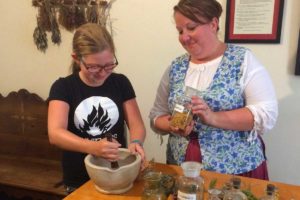 The Spanish Military Hospital Museum enables visitors to travel back in time to St. Augustine in the late 18th century. Focusing on the Second Spanish Period, the museum provides visitors with a unique insight into the “cutting edge” medical practices of the Colonial era. This captivating glimpse into the past is hosted in a reconstructed building that has been furnished to reflect the various rooms of an 18th-century hospital. The museum brings to life the experiences of a doctor and patient in 1790s St. Augustine.
The Spanish Military Hospital Museum enables visitors to travel back in time to St. Augustine in the late 18th century. Focusing on the Second Spanish Period, the museum provides visitors with a unique insight into the “cutting edge” medical practices of the Colonial era. This captivating glimpse into the past is hosted in a reconstructed building that has been furnished to reflect the various rooms of an 18th-century hospital. The museum brings to life the experiences of a doctor and patient in 1790s St. Augustine.
The guided tour features demonstrations of period surgical procedures as well as the methods pharmacists used to create various medicines for the treatment of soldiers who were sick and injured. You will view period medical instruments and learn about the development of medical practices that are still in use, such as cleanliness and quarantine standards that prevented illness and the spread of disease. The doctors would combine medical knowledge from Europe and Africa to achieve remarkable survival rates. In addition to the operating room, you will see the administration office, patient wards and the morgue as well as the mourning room. A bell would ring to summon mourners; this practice inspired the phrase “For whom the bell tolls.” The tour also includes the apothecary garden where an assortment of medicinal plants and herbs are grown. You will gain insights into these natural ingredients that serve as the basis for some of today’s most popular medications.
Visitor Information

HOURS & ADMISSION
- 10:00 am – 6:00 pm
- Last Tour: 5:45 pm
- Guided Tours begin every 15-20 minutes
ADMISSION FEE
- Adults: $9.50
- Seniors (60+): $8.00
- Children 5-12: $4.50
- Military: $5.00 – ID Required
PHONE & ADDRESS
- Address: 3 Aviles St.
- Phone: (904) 342-7730
- Website: www.spanishmilitaryhospitalmuseum.com
Things to Do Nearby
 Ximenez-Fatio House Museum
Ximenez-Fatio House Museum
Ximenez-Fatio House Museum is considered one of the most authentic and best-preserved homes of the Second Spanish Period. Built in 1798, it was originally a merchant’s home and place of business. Furnished with period pieces, the house museum celebrates its role as a fashionable boarding house during the area’s first tourism boom.
 Government House
Government House
Located in Town Plaza, Government House is a historic building that has served numerous public roles over the centuries. Constructed from coquina circa 1710, it was the official residence of the royal governor. In addition to being used as a courthouse, the building also served as an early capitol for the newly created Territory of Florida. The lobby houses a museum that hosts rotating exhibits.
 Cathedral Basilica of St. Augustine
Cathedral Basilica of St. Augustine
Inspired by Spanish Colonial architecture, the Cathedral Basilica of St. Augustine is the oldest Catholic parish in the city. Completed in 1797, the church features historic murals, intricate stained glass windows and the oldest bells in the country.
 Bridge of Lions
Bridge of Lions
Spanning the Intracoastal Waterway, the Bridge of Lions is a double-leaf movable bridge that features an entranceway flanked by two Carrara marble Medici lions. Opened in 1927, the bridge was designed by J.E. Greiner, whose daughter poured the first bucket of concrete. It is considered one of the most scenic bridges in the South and an iconic symbol of St. Augustine.



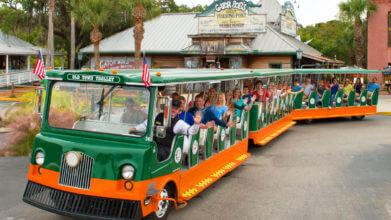

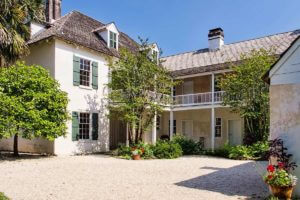 Ximenez-Fatio House Museum
Ximenez-Fatio House Museum Government House
Government House Cathedral Basilica of St. Augustine
Cathedral Basilica of St. Augustine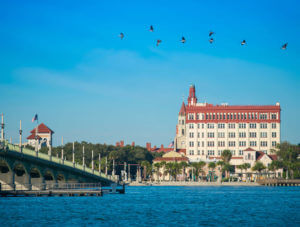 Bridge of Lions
Bridge of Lions
